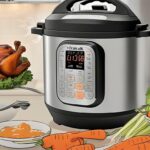Hungry and eager to whip up a culinary masterpiece, you enter the kitchen with fresh ingredients and a hunger for success. As you reach for your trusty frying pan, a thought strikes you: Do you know how to handle it properly, whether it’s sizzling hot or chillingly cold?
Fear not, aspiring chefs and home cooks, for in this blog post, we’ll unlock the secrets to mastering the art of frying and panhandling. Prepare to conquer the stove with finesse, avoid any kitchen mishaps, and serve up delectable dishes that will have your taste buds dancing with delight.
So grab your apron and prepare to elevate your culinary skills to new heights – it’s time to dive into the dos and don’ts of handling a frying pan, regardless of its scorching temperature or icy coolness.
Precautions when Handling a Hot Frying Pan:
- Understand the potential hazards: When handling a hot frying pan, knowledge is power. The first and most crucial step is to understand the potential hazards involved. A scorching hot pan can cause painful burns, not to mention other accidents if mishandled. By recognizing these risks, you’ll be better equipped to prioritize safety throughout your cooking process.
- Use appropriate protective gear: Now that you know the dangers, it’s time to gear up for protection. Oven mitts or pot holders are your new best friends when handling a hot frying pan. These heat-resistant accessories are a barrier between your precious hands and the searing heat. Choose mitts or holders that fit comfortably and provide adequate insulation, ensuring you can handle the heat without discomfort or accidents.
- Establish a safe grip: A firm and secure grip on a hot frying pan is paramount. To achieve this, follow these simple steps. First, ensure the mitt or holder protects your hand. Then, use a towel or cloth to add an extra insulation layer around the handle. This will create a barrier against the intense heat. Always keep your hand positioned on the far side of the handle, away from the hot surface. Maintaining a stable grip and proper hand placement will give you better control over the pan, reducing the risk of accidental slips and spills.
So, put on those oven mitts and dive into frying panhandling! Remember, safety should never be compromised when handling a hot frying pan. By understanding the potential hazards, using the right protective gear, and establishing a secure grip, you’ll be well on your way to conquering the heat and creating culinary wonders in your kitchen.
Proper Techniques for Handling a Cold Frying Pan:
1. Assess the temperature:
While a cold frying pan may not pose an immediate risk of burns, it’s still essential to assess its temperature before handling it. A common mistake is assuming that all frying pans are cool to the touch, which can result in an unexpected encounter with residual heat. To avoid any surprises, lightly touch the pan’s surface with the back of your hand or fingertips. If you feel any warmth, it’s best to wait a little longer for the pan to cool down completely.
2. Ensure a stable surface:
Before you even think about grabbing that cold frying pan, please take a moment to consider the surface it rests upon. A stable and heat-resistant surface is crucial for safe handling. Opt for a heat-resistant mat, trivet, or a designated area on your kitchen countertop to place the pan. This simple precaution protects your countertops from heat damage and ensures that the pan won’t wobble or slide during handling, reducing the risk of accidents.
3. Choose the right utensils:
When handling a cold frying pan, the right utensils can make all the difference. Look for utensils with heat-resistant handles or grips, providing an added layer of safety and comfort. A spatula or tongs with insulated handles are excellent choices.
These utensils not only offer a secure grip but also minimize the transfer of heat from the pan to your hand. By selecting the appropriate tools, you’ll have greater control and confidence when maneuvering a cold frying pan.
You can easily handle a cold frying pan by following these proper techniques. Remember to assess the temperature, ensure a stable surface, and choose the right utensils. Whether flipping pancakes or searing a steak, these practices will help you navigate the kitchen like a pro, keeping accidents at bay and allowing you to focus on creating mouthwatering culinary delights.
Does Frying Pan Handles Get Hot?
Insulated handles can’t conduct heat. However, heat could be felt through other means besides conduction, but this depends on one’s position of the handle to the heat. For instance, heat could convent to burning your fur and palms when touching the handle if its length isn’t so long. Furthermore, the handles’ nadir position, length, lifted crest, and designs will determine the heat transfer’s tenacity level.
What Direction Should a Pan Handle be Facing?
It should be facing opposite the direction of the fire blazing the bottom of the frying pan. Immensely bombarding the pan with fire could make the entire frying pan ooze enormous heat. The shape of the handle should look like an arc seemingly above the frying pan’s surface top.
This should keep the hand 5 inches from the frying pot and between 7 inches and 10 inches from the burning flame of the stovetop. Indeed, that’s why it’s expedient for a handle to be 7 inches long or more from a pan’s tip.
Which Type of Handle on a Cooking Pan Gets Hot?
Frying pan handles made of glass or metals conduct heat. Steams could transmit heat during evaporation and condensation. Though this kind of heat can’t melt an insulated handle, but its impact can’t be felt because heat is transferred through convention in the medium.
Cooking pan handles of metals like iron, copper, zinc, aluminum, stainless steel, etc., conduct heat. Likewise, cooking pans with glass protruding from the frying pan could conduct heat, making it hot.
What is Used as the Handle of the Frying Pan?
1. Metals:
Handles with metals like steel, tungsten, and bronze have low thermal conductivity. Some fry pans have any of these, and they conduct heat when it’s intense. Besides, some are coated with insulating materials but aren’t when shielded.
2. Glass:
Glasses could be tempered to augment their heat resistance. Meanwhile, some others aren’t treated as such. Glasses with an infusion of silica and lead are great at designing frying pan handles. Nevertheless, the fact that they have low heat conductivity doesn’t mean they don’t transfer heat.
3. Woods:
oaks and the like are used to design frying pan handles. Woods that aren’t susceptible to decomposition are often used for frying pans. Notwithstanding, some people don’t go for this because it’s not as durable as other types.
4. Thermosetting Resin:
This frying pan handles have thick plastic on their ends. The plastic is called thermosetting resin. It has high resistivity to heat conduction and melting. It doesn’t absorb stains, and you can use it for a long time.
 Final Words
Final Words
Mastering the art of handling a frying pan, whether hot or cold, is a skill that every aspiring chef and home cook should possess. By understanding the precautions when dealing with a hot pan, such as recognizing potential hazards, using proper protective gear, and establishing a safe grip, you can safeguard yourself against burns and accidents.
Similarly, when handling a cold frying pan, assess the temperature, ensure a stable surface, and choose utensils with heat-resistant handles. These practices will enhance your safety and give you greater control and confidence in the kitchen.
So, let seamless pan maneuvering, delectable dishes, and a touch of kitchen mastery mark your culinary journey. With these tips, you can embrace the heat and conquer the stove with finesse.
- What is a Stock Pot Used for in Cooking? - September 5, 2023
- How to Make Turkey Stock in Instant Pot - September 5, 2023
- How to Make Gravy from Pot Roast Stock - September 5, 2023






